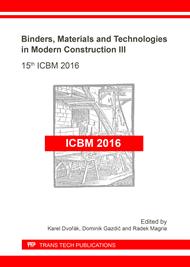p.71
p.76
p.83
p.88
p.94
p.100
p.106
p.111
p.118
Lightweight Aggregate Produced with Cold-Bonding of Fly Ash and Binder
Abstract:
Main object of this paper are results of ash usage in order to create artificial aggregates. Ashes are mineral residue of coal burning in thermal power stations. Fly ashes (high temperature ashes) are highly used in practice as supplement of cement and silicate components of silica materials. FBC ashes are not used such great scale. They can be used for restoration, mounds or for example also for production of ash autoclaved aerated concrete. [1] Production of artificial aggregate from sintered ash is possible mainly because of the fly ashes. [2] Focus of this paper is to compare various types of ashes for lightweight aggregate produced with cold-bonding. Apart from the fly ashes and FBC ashes are also tested bottom ashes from FBC technology. From the results could be assumed, that bottom ashes compared to their granularity could be used only very hardly. Fly ashes splendidly react with cement and reach higher strengths. But they need more than 10 % of binder in order to reach quality results. FBC ashes better cooperate with quicklime, but in order to reach suitable parameters they need smaller portion of binder.
Info:
Periodical:
Pages:
94-99
Citation:
Online since:
October 2017
Authors:
Keywords:
Price:
Сopyright:
© 2017 Trans Tech Publications Ltd. All Rights Reserved
Share:
Citation:


